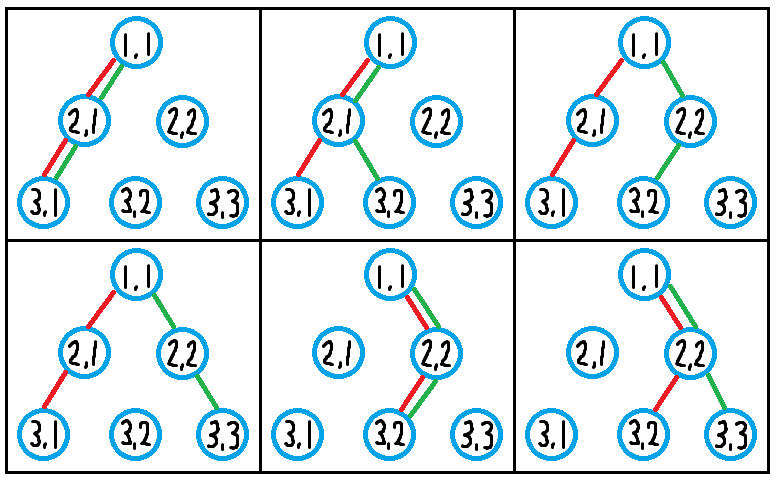Time limit : 4sec / Memory limit : 256MB
Score : 1600 points
Problem Statement
There are N(N+1)?2 dots arranged to form an equilateral triangle whose sides consist of N dots, as shown below. The j-th dot from the left in the i-th row from the top is denoted by (i,j) (1≤i≤N, 1≤j≤i). Also, we will call (i+1,j) immediately lower-left to (i,j), and (i+1,j+1) immediately lower-right to (i,j).

Takahashi is drawing M polygonal lines L1,L2,…,LM by connecting these dots. Each Li starts at (1,1), and visits the dot that is immediately lower-left or lower-right to the current dots N?1 times. More formally, there exist Xi,1,…,Xi,N such that:
- Li connects the N points (1,Xi,1),(2,Xi,2),…,(N,Xi,N), in this order.
- For each j=1,2,…,N?1, either Xi,j+1=Xi,j or Xi,j+1=Xi,j+1 holds.
Takahashi would like to draw these lines so that no part of Li+1 is to the left of Li. That is, for each j=1,2,…,N, X1,j≤X2,j≤…≤XM,j must hold.
Additionally, there are K conditions on the shape of the lines that must be followed. The i-th condition is denoted by (Ai,Bi,Ci), which means:
- If Ci=0, LAi must visit the immediately lower-left dot for the Bi-th move.
- If Ci=1, LAi must visit the immediately lower-right dot for the Bi-th move.
That is, XAi,Bi+1=XAi,Bi+Ci must hold.
In how many ways can Takahashi draw M polygonal lines? Find the count modulo 1000000007.
Notes
Before submission, it is strongly recommended to measure the execution time of your code using "Custom Test".
Constraints
- 1≤N≤20
- 1≤M≤20
- 0≤K≤(N?1)M
- 1≤Ai≤M
- 1≤Bi≤N?1
- Ci=0 or 1
- No pair appears more than once as (Ai,Bi).
Input
Input is given from Standard Input in the following format:
N M K
A1 B1 C1
A2 B2 C2
:
AK BK CK
Output
Print the number of ways for Takahashi to draw M polygonal lines, modulo 1000000007.
Sample Input 1
3 2 1
1 2 0
Sample Output 1
6
There are six ways to draw lines, as shown below. Here, red lines represent L1, and green lines represent L2.
Sample Input 2
3 2 2
1 1 1
2 1 0
Sample Output 2
0
Sample Input 3
5 4 2
1 3 1
4 2 0
Sample Output 3
172
Sample Input 4
20 20 0
Sample Output 4
881396682
题目大意
有一高度为N的三角形,共有M条线从顶部走到底部,要求第L+1条线不能在第L条线的左边,有K个要求,要求第a条线必须在第b层向某方向走(c为一即向左,为二则向右),问共有几种情况
分析
轮廓线DP
代码
#include<iostream>
#include<cstdio>
#include<cstring>
#include<string>
#include<algorithm>
#include<cctype>
#include<cmath>
#include<cstdlib>
#include<queue>
#include<ctime>
#include<vector>
#include<set>
#include<map>
#include<stack>
using namespace std;
int dp[1048580];
int need1[21],need2[21];
int put[1048580],go[1048580][21];
//go是记录将一条先向左再向右边翻折后的形状
//put记录一直延左走的第一个与其他线相交的点
int n,m,k;
int main()
{ int i,j,p,q,a,b,c;
scanf("%d%d%d",&n,&m,&k);
for(i=1;i<=k;i++){
scanf("%d%d%d",&a,&b,&c);
a--,b--;
need1[a]|=(1<<b);
need2[a]|=(1<<b)*c;
}
n--;
memset(go,-1,sizeof(go));
memset(put,-1,sizeof(put));
for(i=0;i<(1<<n);i++){
int num=0;
for(j=0;j<n;j++)
if(i&(1<<j)){
if(j>0&&!(i&(1<<(j-1)))){
go[i][num]=i^(1<<j)^(1<<(j-1));
//i指路径,num指第几个向右
}
num++;
}
}
for(i=0;i<(1<<n);i++)
for(j=n-1;j>=0;j--){
if((i&(1<<j)))continue;
put[i]=i^(1<<j);
break;
}
dp[0]=1;
for(i=0;i<m;i++){
for(j=0;j<(1<<n);j++)
if(put[j]){
dp[put[j]]+=dp[j];
dp[put[j]]%=1000000007;
}
for(p=0;p<n;p++)
for(j=(1<<n)-1;j>=0;j--)
if(go[j][p]!=-1){
dp[go[j][p]]+=dp[j],
dp[go[j][p]]%=1000000007;
}
for(j=0;j<(1<<n);j++)
if((j&need1[i])!=need2[i])
dp[j]=0;
}
int ans=0;
for(i=0;i<(1<<n);i++)
ans+=dp[i],
ans%=1000000007;
printf("%d\n",ans%1000000007);
return 0;
}
